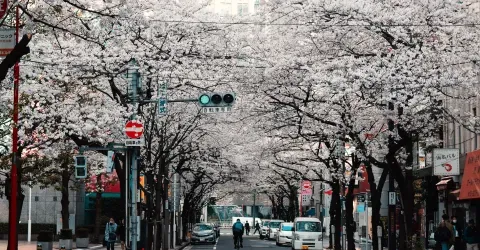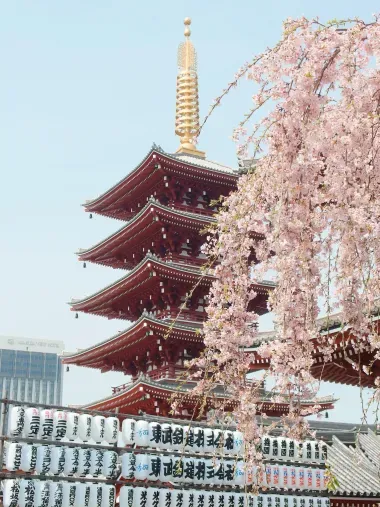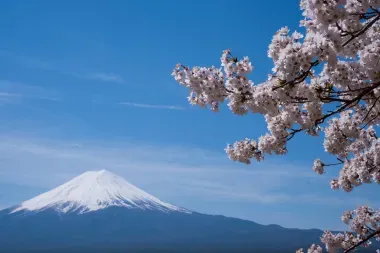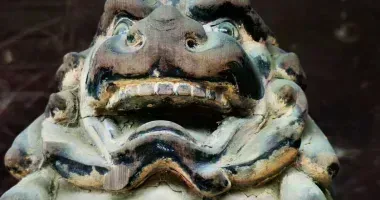Timeless, but fragile, sakura

Cherry blossoms in Tokyo
Agatha Marty
The heart of Japan: Cherry blossoms
Discussion about the love affair between Japan and the Sakura, with the Secretary-general of the Japanese Cherry Association.
Hanami Insurance
Kazy Hata, president and founder of the online insurance company Justincase, thinks he has found THE product that will launch it: hanami insurance, named after the Japanese custom of gathering among relatives at the foot of cherry trees at the time of their flowering. Often to share food and alcohol, or even for outdoor karaoke sessions.
- To read: The origins of Hanami
"You never know. If you get drunk, you could have an accident!", explains this young start-upper in his office in central Tokyo with communicative aplomb. The product has already been approved by the Financial Services Agency. “We are too late for a launch this year but we will be ready for 2020”, he assures.
A somewhat fanciful innovation, but it reminds us that cherry blossoms, although rooted in Japanese tradition, have never been so contemporary. If this tree entered the popularity rankings in Japan, it would surpass most politicians...
A visit to Shinjuku Park in Tokyo, one of the most famous observation spots in the country, demonstrates this: under roofs of white flowers, groups of Japanese have unfolded tarpaulins and taken out their picnic kit. Around the trees gravitate, like spinning tops, the proverbial Japanese amateur photographers, harnessed as if on an African safari in search of the most beautiful shot, trying to avoid the tourists who would spoil the photo. With great difficulty, as the latter show themselves to be restless and inventive: newlyweds, fashion photographers, Chinese retirees, girlfriends on the go… All live a brief and exceptional moment in their lives. Like the cherry tree.
The Japanese craze for cherry blossoms is well known and documented. He would have been born at the time of the Heian period (794-1185) at the Imperial court, they would have gradually won the warrior class of samurai to end up with that of ordinary mortals. The latter continue to press en masse at their feet each spring; they are then the subject of information bulletins at the appearance of the first petals, in the south, in Okinawa, until their disappearance in the north, in Hokkaido. This vertical surge of flowers recalls the very "latitudinal" nature of the land, narrow and long: we are never more than 200 kilometers from the sea in Japan, with its territory stretched over 3500 kilometers from north to south.
The time before
More prosaically, the sakura has its roots in the time before the spectacular progress that propelled Japan from a technically backward country in the middle of the 19th century, to an industrial superpower a century later. It symbolizes for the Japanese the love of simple and free pleasures, opposable to a life where everything is more and more expensive.
The persistent cyclicity of time too, cut into seasons that repeat themselves ad infinitum despite the Promethean time. The flowering takes place at a pivotal moment in collective life: the fiscal year ends at the end of March, as well as the period of hiring campaigns, end-of-study diplomas, and other rites that punctuate life. of the Japanese.
It is opposed to another rite, that of the russeting of autumn leaves, or koyo, which is more melancholy at the approach of winter.
- Discover: Kôyô, autumn in red and gold
Finally, the cherry tree in blossom represents the attachment to nature, as if besieged in increasingly massive, vertical, intimidating metropolises, where parks and gardens shrink in the shadow of skyscrapers. The sakura is never more touching than in the middle of the street in Tokyo, spared by the concrete that covers everything. Despite its fragility, it can also be seen as the symbol of military virtues and in particular of the sacrifice of young suicide bombers during the Second World War.
In these times of peace and the next Rugby World Cup in 2019, the Japanese national team is nicknamed the Brave Blossoms, or "brave flowers", irresistibly evoking the Cherry blossoms (cherry blossoms).
tomorrow
The Japanese worship him so much that they have become an object of fascination for the rest of the world.
How do explain the behavior of these thousands of people on the lookout for flowers each year? "The sakura is a moment that makes us feel the truth of the seasons. Its ephemeral flower blooms in a few days during spring. It is a special moment, especially for the Japanese who live in a region where winter is very cold and snowy. I have a theory: I think that in the old days, when the Japanese people lived off the land, especially rice farming, and they could not measure the temperature accurately, they used the cherry blossoms to regulate their agricultural rhythms. They could determine when to start sowing and grow rice sprouts without fear of frost. The sakura is the companion of our peasants. That is why it remains apart for the Japanese said Nobuyuki Asada, secretary-general of the Japanese Cherry Blossom Association (Nihon sakura no kai).
Cherry Blossom may also be a masterpiece in jeopardy. How would it escape the climatic upheavals?
"Already the rainy season is no longer the same," worries Nobuyuki Asada. Sudden and frequent changes in temperature, rainy days combined with bright sunshine at this time of year make this miracle very risky. "If a Frenchman wants to do a hanami tour in Japan, I recommend that he choose his itinerary according to the flowering of the cherry trees from south to north. Each region has its interest and its particularity. The important thing is to be able to observe the cherry trees from the start of flowering until the petals fall," he advises.
On good terms…











